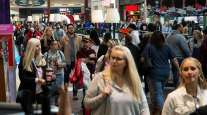Consumer Spending Rises in July as Wages Pick Up

Consumer purchases climbed in July as incomes grew, showing the biggest part of the U.S. economy was off to a good start to the quarter.
The 0.3% advance matched the prior month’s gain, a Commerce Department report showed Aug. 28. The median forecast in a Bloomberg survey of 77 economists called for a 0.4% increase. Wages rose by the most this year.
Coming on the heels of data showing spending and the overall economy did better than previously estimated in the second quarter, the figures indicate the momentum carried over into the second half of the year. Steady hiring, cheap gasoline, rising home equity and low borrowing costs are underpinning demand and helping shield the United States from global weakness.
“The consumer is pretty much chugging along,” said Tom Simons, an economist at Jefferies in New York, who correctly forecast the spending gain. “It’s clearly encouraging to see the wage gain. We definitely need more of that to see a sustained acceleration in consumption.”
Projections for spending ranged from gains of 0.2% to 0.6%. The previous month’s reading was revised up from an initially reported 0.2% advance.
Total incomes rose 0.4% in July, matching the median forecast in the Bloomberg survey. Wages and salaries increased 0.5%, the biggest gain since November.
Because spending increased less than incomes, the saving rate rose to 4.9% from 4.7%.
The report also showed that adjusting consumer spending for inflation, which generates the figures used to calculate gross domestic product, purchases rose 0.2% after being little changed the previous month.
Economic growth accelerated to a 3.7% annualized rate in the second quarter, revised up from a previously reported 2.3% pace and following a 0.6% gain in the first quarter, according to Commerce Department data released Aug. 27. The 3.1% jump in household purchases also was more than the prior estimate.
Details of the July spending and income report showed durable goods purchases, including automobiles, jumped 1.3% after adjusting for inflation, with about half the gain coming from demand for autos and parts. That followed a 0.9% drop. Spending on nondurable goods, which include gasoline, rose 0.1%.
Household outlays on services also rose 0.1% after adjusting for inflation. The category, which includes tourism, legal help, health care and personal care items such as haircuts, is typically difficult for the government to estimate accurately.
The report showed inflation remained tame. The price gauge based on the personal consumption expenditures index increased 0.1% from the prior month and was up 0.3% from a year earlier.
The core price measure, which excludes food and fuel, also rose 0.1% from the prior month and was up 1.2% from July 2014, the smallest year-to-year gain in four years.
Inflation hasn’t reached the Fed’s 2% goal since April 2012.
Consumers are getting a boost from an improving job market. Payrolls climbed by 215,000, and the unemployment rate was at a seven-year low of 5.3% in July.
Gasoline prices have fallen almost 30 cents a gallon since this year’s high of $2.80 reached in the middle of June, data from auto group AAA showed.
Fed policymakers, considering raising the benchmark interest rate for the first time since 2006, are watching the global stock market turmoil.
While recent stock-market gyrations may trim household wealth, cheaper fuel and steady hiring will provide some offset, economists have said. That will help cushion the economy from slowing overseas sales and financial turbulence worldwide, they predicted.




